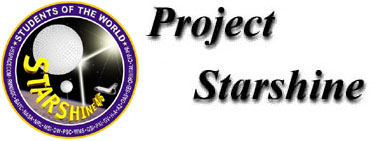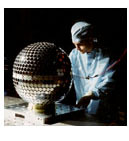|
A new volunteer "Starshine on Station" team is working on a concept for attaching a lightweight, controllable mirror to an unused handrail on the outside of the International Space Station (ISS) and using the mirror to send brief, daylight-visible Morse Code messages to students around the world in the various languages of the countries that are building the the ISS. In this proposed concept, the schools that observe, decode and translate our messages properly will qualify to enter a weekly Internet-based, multiple-choice contest to correctly identify the various physical elements of the ISS and their functions, as well as the names of the nations that have built them, the names and nationalities of the current ISS crew members and some of the experiments they are performing.
The Internet addresses of NASA web sites that contain the correct answers to the questions will be provided to the qualifying schools. The contest will be sub-divided into elementary school, middle school and high school levels (or their equivalents in various countries). The winning school in each of these three categories each week will be rewarded by having their school's name announced from space over live NASA TV by the crew of the ISS. Also, a high-fidelity scale model kit of the ISS will be shipped to each of the three winning schools each week. Schools that are not successful in winning a weekly contest may re-apply the following week.
|
This is a proposed concept only at the present time. Our volunteer "Starshine on Station" team has offered to build the mirror, its control system, solar array, battery, radio receiver, and attachment device at no cost to the government and to operate the mirror and conduct the Internet contest without any impact on normal ISS operations. NASA Headquarters is considering whether to accept our offer at this time and investigating when and if it might be possible to send the system up on a Shuttle mission and attach it to the ISS.
Here is an image of Ted Stern of Composite Optics, Inc. of San Diego, CA, holding the Graphite Fiber Reinforced Composite structure of a half-meter-diameter, 2 kilogram mirror that he and his colleagues have offered to provide us for this project for free. He is preparing to replicate the surface of this mirror to a flatness of approximately one wavelength of light at 530 nanometers. This mirror will provide flashes of sunlight of equivalent stellar magnitudes between minus 6 and minus 7, depending on the geometry of the sun-mirror-observer sight lines and the distance from the ISS to the observer. These flashes will be bright enough to be visible to the average observer in broad daylight, under reasonably clear sky conditions.
|
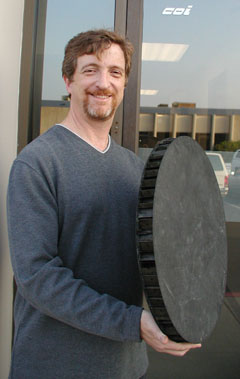
|
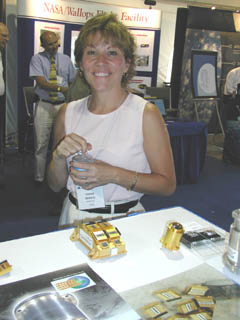
|
Here is an image of Celeste McGorty of Goodrich Corporation Optical and Space Systems with an analog sun sensor assembly and a horizon sensor that her company is considering giving to our "Starshine on Station" project for free. These two systems will be combined to locate the sun as a reference from which our mirror will be controlled to point a half-degree-wide reflected beam of sunlight to each applying school beneath the ISS's orbital track on one of its 16 orbits of the earth each day.
|
|
Here is an image of Mark Bailey of Starsys Research Corporation (on the
right) and Gil Moore, director of the "Starshine on Station" project (on the
left), with one of Starsys' lightweight bi-axis gimbal actuators that Mark
has committed to provide to this project for free.
Commands to point this actuator to reflect a beam of sunlight to each school will be communicated to a U.S. Naval Academy amateur radio receiver in the "Starshine on Station" instrument package. Bob Bruninga of the Naval Academy will supervise a team of amateurs around the globe to transmit these messages to his receiver. Paul Graziani, president of Analytical Graphics, Inc., has committed his company to calculate the appropriate control angles required to point a beam of sunlight and "dither" the mirror to send Morse Code messages to each selected school, in turn.
Additional reports will be published from time to time on this web page, highlighting other members of the "Starshine on Station" team and their contributions to our project. We will also report on NASA's decision about whether to accept our offer as soon as that occurs.
Questions and comments about the project should be emailed to Gil Moore at
gilmoore12@aol.com or telephoned to him at 719-488-0721.
|
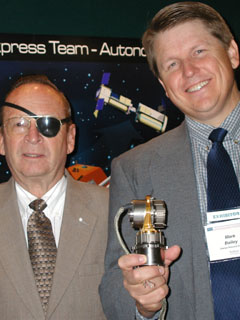
|
Starshine Update Archives
Return to Project Starshine Home Page
Last Updated: November 6, 2002
|
